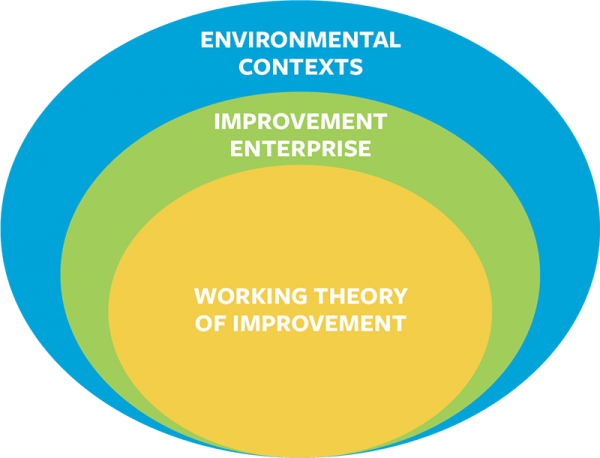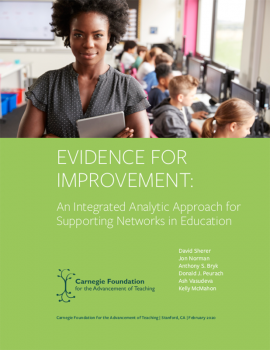Evidence for Improvement: An Integrated Analytic Approach for Supporting Networks in Education
Across the social sectors, a growing number of organizations are embracing continuous improvement models and organizing themselves as networks to attack complex problems. To succeed, networks must learn quickly by studying their own practices, continuously adapting to changing circumstances within their organizations and in the broader environment, and incorporating this learning into their ongoing work.
This paper describes our integrated Evidence for Improvement (EFI) approach that outlines how a variety of tools and practices drawn from diverse forms of program evaluation can inform the leaders of networks in advancing productive change. In addition, improvement networks can be conceptualized and measured using a three-level nested model (see Figure 1) composed of (1) a working theory of improvement, (2) an improvement enterprise, and (3) environmental contexts.

Figure 1: The Three-Level Nested Model of Improvement Networks
As those with evaluative expertise engage in inquiry targeted at each of these levels, they become authentic partners with improvement leaders and fully align their analytic efforts with the improvement activities and social contexts of the network. The EFI approach is designed to enhance a network’s internal learning processes and, in turn, lead to more positive impacts for educators and students. It has implications for improvement practitioners, evaluators, and funders.
The EFI approach builds on evaluation techniques developed over the last 50 years to craft a coherent and integrated framework that can guide future evaluative efforts for continuous improvement networks. We see the primary contribution of this paper as making more visible the connections between (1) longstanding practices in program evaluation and, (2) the gathering and use of evidence for continuous improvement carried out through structured networks.
Evidence for Improvement: An Integrated Analytic Approach for Supporting Networks draws on our direct experiences working with improvement networks, a review of existing writing in the evaluation field, and the advice and opinions of prominent evaluators and scholars who study the use of evidence and joined with us in this inquiry. We encourage future research and writing to examine and investigate the usefulness of the practices proposed here in pursuit of a more refined understanding of how working analysts might use them. Such inquiry has the potential to advance our understanding of the best way to support networks as they engage in the challenging work of continuous learning and improvement.






